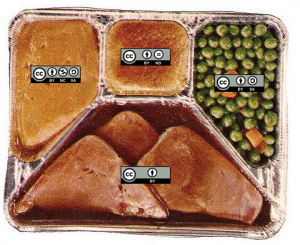24 Collections
What is a Collection? |
A work or creation that is selected and arranged by the following:
- Unmodified in any form
- Compiled with one or more contributions
- Each work constituting separate and independent in themselves and from each other
- The compilation is assembled into one collective whole
Like a TV dinner, a collection compiles different works together while keeping them organized as distinct separate objects. An example of a collection would be a book that compiles openly-licensed essays from different sources.

When you create a collection, you must provide attribution and licensing information about the individual works in your collection. This gives the public the information they need to understand who created what and which license terms apply to specific content.
When you combine material into a collection, you may have a separate copyright of your own that you may license. However, your copyright only extends to the new contributions you made to the work.
In a collection, that is the selection and arrangement of the various works in the collection, and not the individual works themselves. For example, you can select and arrange pre-existing poems published by others into an anthology, write an introduction, and design a cover for the collection, but your copyright and the only copyright you can license extends to your arrangement of the poems (not the poems themselves), and your original introduction and cover. The poems are not yours to license.
“CC TV Dinner” by Nate Angell. CC BY. Derivative of “tv dinner 1″ by adrigu (https://flic.kr/p/6AMLDF) used under CC BY, and various Creative Commons license buttons by Creative Commons (https://creativecommons.org/about/downloads) used under CC BY.
Unit 4: Using CC Licenses and CC-Licensed Works by Creative Commons CC- BY 4.0
